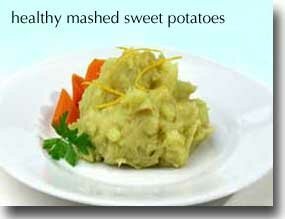If you don't know what to serve for dinner tonight ...
The spice mixture and orange juice in this recipe adds a wonderful complement to the flavor of the sweet potatoes for a great new addition to your Healthiest Way of Eating. It also contains only 98 calories. Enjoy!

Ingredients:
- 2 medium-sized sweet potatoes or yams, sliced thin for quick cooking
- 2 TBS fresh orange juice
- 1/2 tsp garam masala
- 1 TBS extra virgin olive oil
- salt and white pepper to taste
- Bring lightly salted water to a boil in a steamer with a tight fitting lid.
- Steam peeled and sliced sweet potatoes in steamer basket, covered, for about 10 minutes, or until tender
- When tender, mash with potato masher, adding rest of ingredients.
In-Depth Nutritional Profile for Healthy Mashed Sweet Potatoes
Healthy Food Tip
How can I get more omega-3 fatty acids in my daily meals?
You can rely on the World's Healthiest Foods to get you "over the top" on your daily omega-3 fatty acid consumption! While that may seem like a bold claim since the average American adult gets less than 1.5 grams of omega-3 fatty acids per day, many of the World's Healthiest Foods are great sources when it comes to providing substantial amounts of this important nutrient. Walnuts, flaxseeds, beans, fish, olive oil, and winter squash constitute part of the cornucopia of foods that will provide you with concentrated sources of omega 3 fats.
Recommendations for omega-3 consumption
In 2005, the National Academy of Sciences (NAS) established Dietary
Reference Intake (DRI) guidelines for omega-3 fats. These guidelines set
a target range of 1.1-1.6 grams for alpha-linolenic acid (ALA), the
essential omega-3 fatty acid that is the starting point for production
of all other omega-3 fatty acids. Also assumed in this guideline was an
additional 0.1 grams of two other omega-3 fats, eicosapentaenoic acid
(EPA) and docosahexaenoic acid (DHA). These guidelines do not seem as
well-matched to the existing health research on omega 3 fatty acids as
guidelines issued by the Workshop on the Essentiality of and Recommended
Dietary Intakes (RDI) for Omega-6 and Omega-3 Fatty Acids in 1999
sponsored by the National Institutes of Health (NIH). This panel of
experts recommended that people consume at least 2% of their total daily
calories as omega-3 fats. To meet this recommendation, a person
consuming 2000 calories per day should eat sufficient omega-3-rich foods
to prov
ide at least 4 grams of omega-3 fatty acids.
Food sources of omega 3 fats - flaxseeds and walnuts
At the top of my list for increasing omega-3s would be flaxseeds and
walnuts. One-quarter cup of flaxseeds contains about 7 grams of omega-3
fatty acids while one-quarter cup of walnuts contains about 2.3 grams.
In either case, the amount is pretty substantial. Therefore by combining
one-quarter cup of walnuts with a tablespoon of flaxseeds you will add
close to the recommended 4 grams of omega-3 fats to your diet.
Food sources of omega-3 fats - beans
Flaxseeds and walnuts are not your only choices, of course! One cup's
worth of soybeans, navy beans, or kidney beans provides between 0.2 and
1.0 grams of omega-3s. A four-ounce serving of tofu will provide about
0.4 grams of omega-3s. Therefore, these foods provide between 10% and
50% of the National Institutes of Health recommendation, and are a
substantial step up from the average U.S. adult intake.
Food sources of omega-3 fats - fish, winter squash and olive oil
Three other types of foods are important to mention as omega-3
boosters: fish, winter squash, and olive oil. In the case of fish,
you'll get about 2.0 grams from every 4 ounce serving of Chinook salmon;
0.6 grams from the same serving of halibut; and 0.4 grams from tuna. A
cup of winter squash will provide you approximately 0.3 grams. For extra
virgin olive oil, the amount of omega-3s per ounce is about 0.2 grams
(a word about using extra virgin olive oil-don't fry with it as you'll
damage the omega-3s).
Practical tips
When it comes to increasing your omega-3 fatty acids intake, don't
worry about bringing your calculator to the kitchen. All you have to do
is to focus on bringing more omega-3 rich foods into your diet.
Eating fish and seafood such as salmon, halibut, tuna and scallops a few times a week is an easy way to increase your omega-3 intake. Plus you'll get all of the other nutritional benefits that these foods have to offer.
As noted, walnuts and flaxseeds can be important contributors to an omega-3 rich diet. To increase your intake of these foods, adding this nut-seed combination to salads, baked potatoes or granola is just one of the many ways to easily incorporate these foods into your Healthiest Way of Eating. Additionally, if you grind nut butters at home, they could also be used in the above ratio as a nut-seed blend. (Although it is somewhat difficult to clean, a standard coffee bean grinder usually does fairly well as a nut-seed grinder.

No comments:
Post a Comment